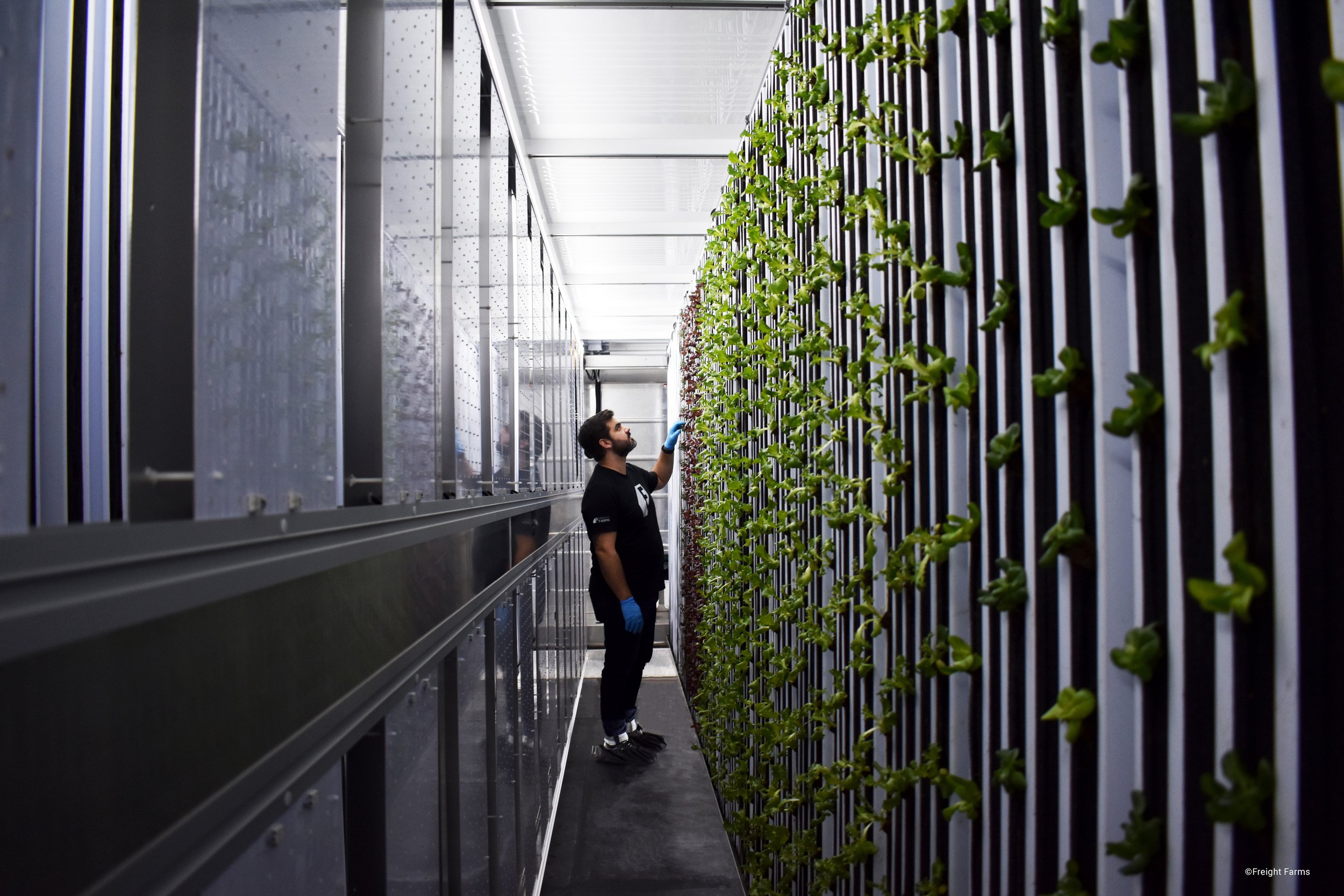Exciting Farming Opportunities for the Modern World
The 'Lost Generation of Farmers' Isn't Lost,
They Just Look Different
If you haven’t heard, we’re in a bit of worldwide farming workforce crisis.
Employment in agriculture has been steadily declining for decades, and the "next generation" of farmers is nowhere to be found. If you’d like a journalist to tell you the same thing, you can choose from this story, this story, this story, this story, this story, or this story.
In spite of this looming crisis, here at Freight Farms we’re feeling a little more optimistic about farming and farmers themselves. In fact, in recent years we’ve witnessed a new generation of farmers pursuing unprecedented new farming business opportunities that are changing the industry. This next generation of farmers are harder to recognize, but it turns out they were hiding in plain sight all along.
The next generation of farmers will collect a diverse range of expertise.
Phil Cuddeback
Former Head Farmer at Square Roots
Even though Phil used to work at Freight Farms, we think his path is representative of the next generation of farmers beyond his work with us.
When we were just a year-old startup, Phil was our jack of all trades. Sure he ran our prototype farm, but he also did research and development to maximize yields, helped our industrial designers improve the next-generation Leafy Green Machine, and worked with customer support team to serve our earliest customers.
Before long, Phil was off to Square Roots. This is Kimbal Musk’s company—they bought ten of our farms back in 2016 and started an urban farming and entrepreneurship incubator. They’re rocking the farm-to-table business in Brooklyn, NY and teaching farmers—in this case hydroponic container farmers—how to run a profitable business.
So if you’re keeping track, Phil has at this point gathered skills in hydroponic growing, hydroponic R&D, engineering, software automation, customer service, team leadership, business management, and he also has background experience in large animal farming, organic soil farming, and even some commercial fishing.
Today, Phil’s on to the next leg of his journey as a next generation farmer: operating his own soil farm in Maine. Would you recognize Phil—veteran of not one but two big-city tech startups, part scientist and part designer—as a farmer if you saw him on the street? Maybe not, but few could argue he’s not as much a farmer as anyone.
The next generation of farmers will be experts in customer service.
Francesca Mazzilli
Full Service Farmer
One of the most exciting growth areas for the next generation of farming professionals is managing farming accounts as part of Grown by Freight Farms program.
Grown by Freight Farms is a Farming-as-a-Service model in which farmers, just like handymen or teachers, are compensated for their work, in addition to the produce they actually grow.
In India, Uber inspired a new startup called EM3 AgriServices, which allows farmers that own tractors, harvesters, and implements to rent out those assets and generate passive revenue. In turn, farmers with limited capital can access state-of-the-art equipment on a pay-as-you-go basis.
In our own backyard, Boston-based Green City Growers will not only design and build an urban garden for you or your company, they’ll maintain the garden and teach you how to run it.
We may soon see a wide workforce of on-site, salaried farmers everywhere from college campuses to corporate cafeterias to hotels and residences, all producing food that couldn’t possibly be more local. Francesca is one of our service farmers but, again, we’re using her to represent something bigger.
Francesca is our principle Grown farmer. She operates Leafy Green Machine on location for a wide variety of customers. One really cool customer is a Boston produce distributor, which can promise its customers fresher produce than any competitor, with stable costs and quality regardless of the weather or season. In exchange, the distributor pays Francesca a monthly fee for her work seeding, transplanting, harvesting, and packing produce, in addition to general farm maintenance.
Of course, by now you may be noticing a trend. Francesca herself is in her twenties at time of writing, born in Milan—a world away from the American Corn Belt, and wouldn’t be caught dead in plaid. If you saw her on the street there’s no way you’d peg her as a farmer, and she never planned to be one, yet she’s as much as farmer as anyone.
The next generation of farmers will grow on farms unlike any we’ve seen.
Corporations, Inventors, and Investors
Futuristic Farmers
Freight Farms specializes in leafy greens, brassicas, herbs, and other crops. But we still represent just a fraction of the overall food system. There’s plenty of room for many different farmers and companies to find success in the new food system.
From warehouse-scale hydroponic farms like Vertical Harvest in Jackson Hole, to “Vertical Forests” proposed to improve urban air quality in Italy, the seeds of innovation are starting to sprout globally.
Last year a Japanese fund led a multimillion dollar investment into Plenty, and thus far all we know of this investment is that it will support the rollout of indoor farms. Beyond that, the possibilities are anyone’s guess. Meanwhile, Amazon unveiled its new “Spheres” building: a massive arboretum with over 40,000 plants grown—not for farming—but merely to “spark employee creativity.”
The ambition, the enthusiasm, and indeed the funding pouring into previously unheard-of forms of agriculture is staggering, and many of these examples first made news within the last 12 months. We have no idea what new and ingenious growing systems will become popular in the next 12 months or the next 12 years, but we’re guessing the farmers running them—just like Phil and Francesca—won’t be recognizable to those with a dated stereotype of what a farmer has to be.
The next generation of farmers will grow in the harshest environment known to mankind.
Astrobotanists
“Space Farmers”
Humans are going to Mars. Officially. And one of the challenges of such an endeavor—among a litany of others—is feeding astronauts enough food that they can survive the journey, subsist on Mars, and get home. We’ve got two options to accomplish this: store all the food and water needed on board, or grow food along the way.
In Andy Weir’s novel, The Martian, protagonist Mark Watney—later played by Matt Damon in the film based on the book—was the mission’s botanist. But if you think this sort of thing is limited to science fiction, you should know NASA is pouring major, real-world funding into astrobotany research.
In 2016, Freight Farms secured a research grant for a method of self-sustaining crop production in space. Such a system would be an entirely closed loop, without any external inputs, operating in a literal vacuum, yet still generating enough food to feed a crew of astronauts.
This year, we and hundreds of other agriculture companies submitted a second proposal to create a lightweight, autonomous farm that would produce food for planetary exploration missions. Successful applicants may not only receive up to $125,000 in research funding (not to mention play a major role in human history), but they will have a significant impact on farmers here on Earth as well. Freight Farms’ proposal—again, just one of many—has secondary “on the ground” applications in disaster response, remote military bases, offshore industries, and more. Plus, NASA itself has a long history of adapting space travel technologies to benefit our daily lives, like LEDs in your TV or memory foam in your mattress.
While true astrobotanists will be one in a million, the next generation of farmers will undoubtedly adopt their techniques. Perhaps future farmers will one day call the system we’re proposing as plain and ordinary as solar panels or freeze-dried ice cream.
Lost and Found
We submit the so-called “lost generation of small farmers” is not lost at all, they merely look substantially different from the farmers we’re used to seeing.
The next generation of farmers will pursue diverse new farming business opportunities, from traditional farming, to vertical farming, to service farming. They’ll respect soil, consider nutrition sacred, but value technology and welcome techniques previously considered impossible or impractical. The next generation of farmers will train up on those new techniques quickly, adding them to their repertoire and diversifying their experience.
They’ll be younger, but they will start their own family farms and small farms too. Just don’t be surprised when those farms start to blend soil beds with hydroponics, aeroponics, aquaponics, and even some solar and wind farming. Don’t be surprised when they extend their season into all 12 months, and don’t be surprised when take on multiple buyers to support multiple business segments.
Most of all, don’t be surprised when you run into a next generation farmer where you least expect it. Maybe in a city, in a food desert, or in your own family. The future farmers are already out there, pursuing unique farming business opportunities to feed the world.














